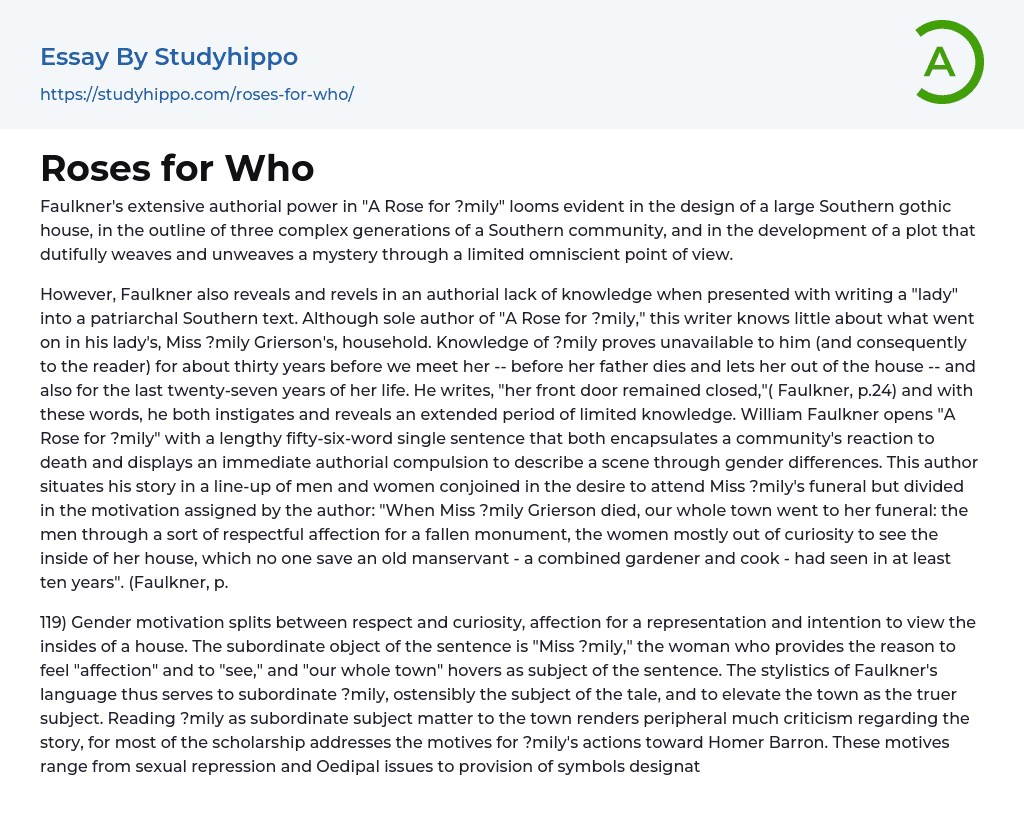The extensive authorial power of Faulkner in "A Rose for Emily" is evident through various elements. This includes the design of a large Southern gothic house, the portrayal of three complex generations within a Southern community, and the development of a plot that intricately unravels a mystery through a limited omniscient viewpoint.
In "A Rose for ?mily," Faulkner explores the theme of authorial ignorance when it comes to portraying a female character within a patriarchal Southern society. Despite being the sole writer of the story, Faulkner admits to knowing very little about Miss ?mily Grierson's life. The reader is kept in the dark about her for approximately thirty years before she is introduced, as well as during the final twenty-seven years of her life. Faulkner conveys this lack of knowledge by stating that "her front door remained closed," indicating an e
...xtended period of limited information. At the beginning of the story, Faulkner presents a lengthy fifty-six-word sentence that captures the community's reaction to ?mily's death and highlights the author's inclination to describe scenes using gender differences. He establishes a division between men and women attending ?mily's funeral, with the men driven by "respectful affection for a fallen monument" while the women are primarily motivated by curiosity to explore her house, which had been unseen by anyone except an old manservant for at least a decade.
(Faulkner, p.)
Gender motivation in the text is divided between respect and curiosity, affection for a representation and intention to view the inside of a house. The woman referred to as "Miss ?mily" is the subordinate object of the sentence, providing the reason for feeling "affection" and the desire to "see," while "ou
whole town" is the subject of the sentence. Faulkner's stylistic choices serve to subordinate ?mily, who is ostensibly the main character of the story, and elevate the town as the true focal point. Interpreting ?mily as a subordinate subject to the town diminishes criticism regarding her actions towards Homer Barron, which has been extensively discussed in scholarly analysis. These motives vary from sexual repression and Oedipal issues to symbolic representation of the shift from the Old South to the new. While scholars have primarily treated the story as a murder mystery and grappled with the revelation of ?mily's "secret," there is a deeper secret at play in the story: why does Faulkner choose to create a narrator with an indeterminate gender to tell this particular story? Until recently, the narrator has been considered of marginal importance in the tale. Hal Blythe's essay from 1988 provides thought-provoking discussion about the narrator, but assumes that the narrator is male. Michael Burduck's essay from 1990 critiques Blythe's article on this very point and argues for a female narrator.
(Blythe, p.4) Both of these approaches maintain the binary significance of words like "male" and "female" in language. Since Faulkner does not specify the gender of the narrator in the text, postmodern critics speculate that he intended either one or the other and part of the enigma of the story is to determine the narrator's gender. Faulkner's "feminism" is an underlying, often unexpressed concern in this search for gender identification.
- Boo Radley essays
- Genesis essays
- Richard iii essays
- Alice in Wonderland essays
- On the road essays
- Ozymandias essays
- The Nightingale essays
- Holden Caulfield essays
- Animal Farm essays
- 1984 essays
- A Hanging essays
- Shooting An Elephant essays
- A Tale Of Two Cities essays
- Adventures Of Huckleberry Finn essays
- Arthur Conan Doyle essays
- Brave New World essays
- Characters In Hamlet essays
- Characters In Romeo And Juliet essays
- Desdemona essays
- Diary Of A Wimpy Kid essays
- First-Person Narrative essays
- Frankenstein essays
- Heart Of Darkness essays
- Jane Eyre essays
- Jay Gatsby essays
- King Duncan essays
- Librarian essays
- Little Red Riding Hood essays
- Lord Of The Flies essays
- Silas Marner essays
- The Cask Of Amontillado essays
- The Catcher In The Rye essays
- The Crucible essays
- The Handmaid's Tale essays
- The Reader essays
- Virgil essays
- Wuthering Heights essays
- Candide essays
- Castle essays
- J. D. Salinger essays
- Ulysses essays
- Ethan Frome essays
- In Cold Blood essays
- Outliers essays
- Tuesdays With Morrie essays
- The Art of War essays
- Wife of Bath essays
- Huckleberry Finn essays
- The Lady With The Dog essays
- Great Expectations essays




